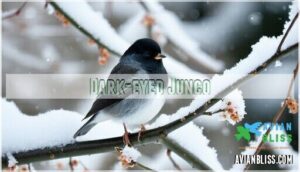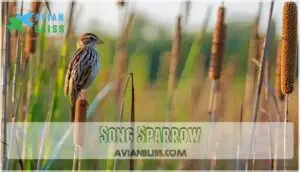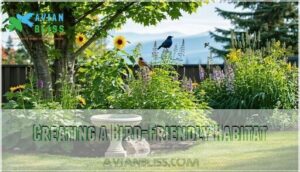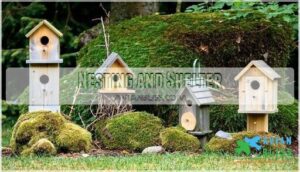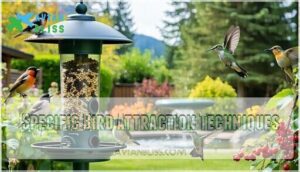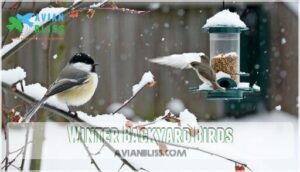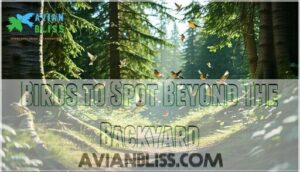This site is supported by our readers. We may earn a commission, at no cost to you, if you purchase through links.
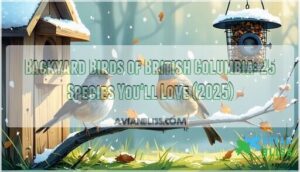 You’ll find Dark-eyed Juncos are the kings of backyard birds of British Columbia, showing up year-round in nearly every yard across the province.
You’ll find Dark-eyed Juncos are the kings of backyard birds of British Columbia, showing up year-round in nearly every yard across the province.
These gray visitors share your space with American Robins, Song Sparrows, and the bold Spotted Towhees that scratch through your leaf piles like tiny gardeners.
Black-capped Chickadees bring endless chatter to winter feeders, while Northern Flickers hammer away at fence posts with woodpecker precision.
From Metro Vancouver to rural Interior properties, BC’s diverse landscape creates perfect conditions for 25 common species that’ll turn your morning coffee into an unexpected wildlife show.
Timing and simple tricks make all the difference.
Table Of Contents
- Key Takeaways
- Overview of Backyard Birds
- Top 25 Backyard Birds of British Columbia
- Attracting Birds to Your Yard
- Year-Round Backyard Birds
- Summer Backyard Birds
- Winter Backyard Birds
- Birds to Spot Beyond The Backyard
- Tips for Birdwatching in British Columbia
- Frequently Asked Questions (FAQs)
- What is a guide to identifying backyard birds in British Columbia?
- Why should you visit the Backyard Birds of British Columbia?
- Which birds visit bird feeders in British Columbia?
- How do I identify a bird in my yard?
- What is B.C.’s official bird?
- How many species of birds are in British Columbia?
- What is killing birds in my backyard?
- How can I identify bird songs by ear?
- What should I do if I find an injured bird?
- Are there specific plants that attract hummingbirds?
- Conclusion
Key Takeaways
- You’ll find Dark-eyed Juncos are BC’s most common backyard visitors, appearing year-round alongside American Robins, Song Sparrows, and Black-capped Chickadees in nearly every yard across the province.
- You can attract 25+ species to your yard by setting up tube feeders with sunflower seeds, suet feeders for woodpeckers, platform feeders for ground-feeders, and fresh water sources like birdbaths.
- You’ll see different birds throughout the seasons – summer brings colorful American Goldfinches and Purple Finches, while winter hosts hardy species like Spotted Towhees and Northern Flickers.
- You’ll create the best bird habitat by planting native berry-producing shrubs, providing dense evergreen shelter for nesting, and positioning feeders at varying heights to attract different species.
Overview of Backyard Birds
You’ll find over 25 bird species regularly visiting British Columbia backyards, from the tiny Anna’s Hummingbird to the striking Northern Flicker.
These feathered visitors change with the seasons, giving you year-round opportunities to observe different species as they feed, nest, and migrate through your outdoor space, providing a chance to see a variety of birds, including the Northern Flicker.
Most Common Backyard Birds
The symphony of Urban Birdsong fills BC backyards with nature’s soundtrack.
You’ll discover these common birds creating a thriving Backyard Ecology where Species Interactions flourish despite Human Impact on local Bird Population.
Here are the top 5 BC birds you’ll spot:
- Dark-eyed Junco – your most frequent feeder visitor
- American Robin – the classic red-breasted neighbor
- Song Sparrow – nature’s melodic performer
- Northern Flicker – the ground-loving woodpecker
- Black-capped Chickadee – the curious acrobat
Bird identification becomes easier once you know these backyard regulars.
Seasonal Distribution
Your backyard transforms with the seasons, showcasing distinct Migration Patterns of BC birds.
Summer Ranges bring vibrant American Goldfinches and Purple Finches, while Winter Habitats host resilient Black-capped Chickadees and Dark-eyed Juncos.
Climate Impacts influence Breeding Seasons and seasonal bird presence.
| Season | Common Species |
|---|---|
| Summer | American Goldfinch, Purple Finch |
| Winter | Black-capped Chickadee, Dark-eyed Junco |
| Year-round | Northern Flicker, American Robin |
Understanding bird migration helps you anticipate these feathered visitors throughout British Columbia’s changing seasons.
Regional Variations
Where you live in British Columbia dramatically shapes which backyard birds you’ll encounter.
Coastal vs. Interior regions showcase distinct species—coastal areas host Anna’s Hummingbirds year-round, while interior locations see more Pine Siskins.
Mountain Birdlife changes with elevation; White-tailed Ptarmigan thrive in alpine zones where few other native birds survive.
Urban Adaptations favor flexible species like House Sparrows and European Starlings, while rural yards attract Spotted Towhees and Fox Sparrows.
Northern Species like Gray-crowned Rosy-Finches appear in BC’s northern reaches.
Island Endemics add unique flavors to coastal bird identification.
Understanding the specific food preferences can help attract the right birds.
Your regional bird species create magical moments:
- The first Anna’s Hummingbird at your coastal feeder
- A Pine Siskin’s acrobatic feeding display
- Mountain silence broken by ptarmigan calls
- Urban chickadees brightening city mornings
- Northern finches visiting during harsh winters
Top 25 Backyard Birds of British Columbia
You’ll discover the most common species that visit British Columbia backyards, from the familiar Dark-eyed Junco to the striking Northern Flicker.
These 25 birds represent the core group you’re likely to spot at your feeders, in your trees, and around your yard throughout the year, making them a key part of the backyards ecosystem.
Dark-eyed Junco
The Dark-eyed Junco earns its "snowbird" nickname through reliable winter appearances in British Columbia backyards.
You’ll recognize these charming birds by their distinctive black hoods and flashing white tail feathers.
Junco subspecies vary slightly, but all share similar ground-foraging behavior.
Their varied diet includes seeds, insects, and berries, making them excellent subjects for bird identification practice.
Northern Flicker
While juncos hop around ground level, Northern Flickers bring woodpecker flair to your British Columbia backyard.
These large, spotted birds pound tree bark with distinctive drumming sounds.
Their flicker diet consists mainly of ants they hunt on lawns.
Watch for their white rump patch during flight.
Flicker sounds include loud "wicka-wicka" calls that’ll help with bird identification during birdwatching adventures.
American Robin
You’ll spot American Robins hopping across your lawn, hunting earthworms with head-tilted precision.
These iconic backyard birds of British Columbia charm with their rusty-red breast and melodic robin song echoing through neighborhoods.
What makes them special:
- Robin diet: Earthworms, insects, and seasonal berries
- Nesting habits: Build mud-lined cups in trees and shrubs
- Migration patterns: Some migrate south, others brave BC winters
Perfect for bird identification practice!
Song Sparrow
Song Sparrows belt out their signature melodies year-round, making them beloved backyard birds in British Columbia.
These brown-streaked singers adapt their diet from insects in spring to seeds in winter.
Their Song Sparrow Song consists of 2-6 clear notes followed by buzzy trills.
| Feature | Details | Season |
|---|---|---|
| Diet Variation | Insects, berries, seeds | Spring-Winter |
| Nesting Habits | Grass cups in shrubs | April-August |
| Identification Tips | Streaked breast, central spot | Year-round |
Downy Woodpecker
You’ll instantly recognize the Downy Woodpecker as one of British Columbia’s most delightful backyard birds.
This tiny black-and-white bird species features distinctive white belly markings and males sport a bright red head patch.
Identifying Downy Woodpeckers becomes easier when you notice their short, chisel-like bills compared to their Hairy Woodpecker cousins.
Downy habitat and behavior:
- Downy nesting: They excavate small cavities in dead wood for raising young, often returning to favorite spots year after year.
- Downy sounds: Listen for their high-pitched whinnying call and rhythmic tapping during bird watching sessions.
Downy diet: These acrobatic feeders enjoy suet, sunflower seeds, and insects, making them reliable feeder visitors.
Attracting Birds to Your Yard
You can transform your yard into a bird haven by providing the right mix of food, water, and shelter that BC’s feeder birds need most.
Setting up feeders with sunflower seeds, suet, and nyjer seed will attract species like Dark-eyed Juncos, Black-capped Chickadees, and Northern Flickers year-round.
Creating a Bird-Friendly Habitat
Success in attracting backyard birds to your British Columbia garden starts with thoughtful habitat design.
Native plants form the backbone of any bird-friendly habitat, providing natural food sources and shelter that local species recognize and trust.
You’ll want to include berry-producing shrubs like serviceberry and elderberry alongside seed-bearing flowers such as sunflowers and coneflowers.
Water sources are essential year-round.
A simple birdbath or shallow dish refreshed daily works wonders for attracting birds.
During winter, consider a heated water feature to prevent freezing.
Shelter options matter just as much as food and water.
Dense shrubs, evergreen trees, and brush piles create safe havens where birds can rest and hide from predators.
Predator control includes placing bird feeders near natural cover but far enough from hiding spots where cats might lurk.
Reducing pesticides protects the insects that many birds depend on for protein, especially during breeding season.
Native plants
Water sources
Shelter options
Providing Food and Water
Three feeder types will transform your yard into a bird magnet. Set up tube feeders for sunflower seeds, suet feeders for woodpeckers, and platform feeders for ground-feeding species.
Place bird baths with fresh water nearby – it’s like rolling out the red carpet for your feathered friends. Consider using specialized seed feeders to attract specific species.
Water sources and seasonal feeding keep backyard birds coming back year-round.
- Watch Dark-eyed Juncos splash joyfully in shallow water
- Hear the satisfying crack of sunflower seeds at your feeder
- See brilliant Anna’s Hummingbirds dart between nectar stations
- Feel the excitement when a Cooper’s Hawk visits your buffet
- Experience the peace of morning coffee with chirping companions
Nesting and Shelter
Beyond food and water, backyard birds in British Columbia need secure places to raise their families. Nest box designs should match specific species requirements—chickadees prefer small entrance holes, while flickers need larger cavities.
Position bird houses 5-15 feet high, facing away from prevailing winds. Scatter natural nesting materials like twigs, moss, and pet fur around your yard.
Cavity nesters appreciate dense shrubs for roosting behavior and predator protection. Creating diverse bird habitats with varying heights gives different species options for safe nesting spots.
Many resources offer advice on choosing proper housing.
Specific Bird Attraction Techniques
Beyond providing shelter, you’ll want specific techniques to bring more backyard birds to your British Columbia yard.
Smart birdbath placement attracts species while proper seed variety keeps them coming back.
Here’s what works:
- Position bird feeders at different heights to attract various species
- Install moving water features to attract hummingbirds with sound and sight
- Offer natural food sources through native berry-producing plants
- Use predator guards to deter cats and hawks from feeding areas
- Rotate seed types seasonally matching bird migration patterns for consistent visits
With over 500 species inhabiting the province, you’ll have plenty of options.
Year-Round Backyard Birds
You’ll find these reliable residents in your yard through all seasons, from snowy winters to hot summers.
Pine Siskins and Steller’s Jays stick around British Columbia backyards year-round, giving you consistent birdwatching opportunities no matter what month you step outside.
Pine Siskin
Pine Siskins show up year-round in British Columbia, bringing acrobatic feeding displays to your backyard.
These small songbirds feature streaky brown plumage with distinctive yellow wing bars – key for Siskin Identification. Their sharp, pointed bills help crack seeds from conifers, birch, and alder trees.
Siskin Diet consists mainly of seeds, though they’ll grab insects during breeding season. Watch for their erratic migration patterns and flocking behavior.
Siskin Habitat includes coniferous forests and suburban yards with mature trees. Supporting Siskin Conservation means maintaining diverse tree species in your landscape.
Steller’s Jay
The Steller’s Jay stands out among British Columbia’s backyard birds with its brilliant blue body and black head crest.
This intelligent species displays remarkable vocal mimicry, copying hawk calls to scare competitors away from feeders.
Despite habitat loss concerns, their conservation status remains stable.
Watch for their clever Steller’s behavior – they’ll remember your birdwatching routines and adapt accordingly.
Summer Backyard Birds
Summer brings a colorful parade of birds to your British Columbia backyard, including the bright yellow American Goldfinch and the melodic White-crowned Sparrow.
You’ll spot these seasonal visitors from May through August as they take advantage of abundant insects, ripening seeds, and longer daylight hours for feeding and raising their young, enjoying the abundant insects.
American Goldfinch
The American Goldfinch transforms your BC backyard into a golden spectacle each summer.
Males showcase brilliant yellow plumage with black caps, while females sport subtler olive-brown tones.
These acrobatic birds cling to nyjer feeders and thistle plants, their vegetarian diet making them unique among backyard birds.
Their late breeding habits coincide perfectly with peak seed availability, ensuring successful nesting.
Purple Finch
Purple Finches bring raspberry-red beauty to your British Columbia backyard during summer months.
These chunky songbirds prefer coniferous forests but visit feeders regularly.
Identification Tips for Purple Finch success:
- Males: Rosy-red head and breast with streaked brown wings
- Females: Brown-streaked with bold facial patterns and thick bills
- Habitat Preferences: Cool, moist coniferous woodlands near feeders
- Diet Variations: Seeds, buds, berries, and occasional insects
Varied Thrush
You’ll recognize the Varied Thrush by its striking orange breast and bold black band.
This secretive bird species prefers dense Thrush Habitat in coniferous forests. Listen for its haunting, single-note Thrush Song echoing through trees.
During Thrush Migration, they move to lower elevations in winter, making backyard appearances more likely in British Columbia’s coastal regions.
| Feature | Description |
|---|---|
| Size | 7.5-10 inches long |
| Thrush Diet | Insects, berries, earthworms |
| Nesting | High in conifer branches |
| Thrush Conservation | Stable populations |
Fox Sparrow
Looking beyond the Varied Thrush’s vibrant display, you’ll discover the Fox Sparrow’s rustic charm in your backyard.
This robust bird scratches through leaf litter like a tiny bulldozer, creating quite the ruckus while hunting.
Here are five key Fox Sparrow characteristics:
- Fox Sparrow ID: Rusty-red streaking on gray-brown plumage with prominent chest spots
- Habitat Preferences: Dense thickets, brushy areas, and woodland edges throughout British Columbia
- Feeding Ecology: Ground-forager eating seeds, berries, and insects using double-scratch technique
- Vocalizations: Rich, flute-like songs and sharp "tschup" calls
- Conservation Status: Stable populations across most bird species ranges
White-crowned Sparrow
White-crowned Sparrows bring distinctive black-and-white striped crowns to your British Columbia backyard during summer months.
These ground-feeding sparrows forage in weedy fields and yards, creating memorable moments for backyard birds enthusiasts.
These birds often display unique lore colors depending on their subspecies.
Their fascinating behaviors include:
- Song Variations: Males develop regional dialects unique to their territory
- Plumage Changes: Crown patterns shift from brown stripes in juveniles to bold black-and-white in adults
- Migration Patterns: They travel thousands of miles between breeding and wintering grounds
Winter Backyard Birds
Winter brings hardy birds to your British Columbia backyard that can handle cold temperatures and snow.
You’ll see active species like Black-capped Chickadees and Spotted Towhees visiting feeders regularly during the colder months.
Black-capped Chickadee
Winter visitors don’t get more charming than the Black-capped Chickadee. These acrobatic backyard birds brighten British Columbia’s coldest months with their signature "chick-a-dee-dee-dee" calls and fearless personalities.
You’ll watch them hang upside-down at bird feeders, stuffing sunflower seeds into bark crevices for later. Their Chickadee Behavior includes caching thousands of seeds daily, while their Chickadee Diet consists of insects, seeds, and berries.
These cavity nesters appreciate properly-sized nest boxes filled with wood shavings, making Chickadee Nesting successful when attracting birds to your winter landscape. They’re also frequent visitors to sunflower seed feeders.
Spotted Towhee
Spotted Towhees bring excitement to your winter backyard with their striking red eyes and fan-shaped tails.
These common birds prefer dense shrubs where they perform their signature double-scratch feeding technique.
Towhee identification becomes easy once you spot males’ black heads contrasting with females’ brown caps.
Their towhee diet includes seeds, berries, and insects found beneath leaf litter.
Towhee behavior includes that distinctive "drink-your-tea" call echoing through British Columbia’s winter gardens, making birdwatching truly rewarding.
Birds to Spot Beyond The Backyard
You’ll find British Columbia’s best bird species waiting beyond your backyard fence at local parks, wetlands, and nature reserves.
These prime birding locations offer chances to spot over 500 documented species that rarely visit residential feeders, from waterfowl at coastal marshes to forest songbirds in mountain trails.
Top 5 Hotspots for Birdwatching
Beyond your backyard birds, British Columbia’s diverse landscapes offer exceptional birdwatching hotspots across Coastal Hotspots, Mountain Habitats, and Urban Sanctuaries.
These prime locations showcase Migratory Routes and provide opportunities for Rare Sightings that’ll expand your birding experience.
Here are the top five birdwatching destinations:
- Iona Island – Coastal photography paradise
- Salmon Arm Bay – Autumn migration spectacle
- Reifel Bird Sanctuary – Expert bird guide tours
- Boundary Bay – Expansive tidal flats
- Burnaby Lake – Peaceful urban sanctuary
Rocky Point Bird Observatory
Rocky Point Bird Observatory stands as British Columbia’s premier research station, where banding programs help track migration patterns of native birds you might spot at your bird feeders.
Observatory history dates back decades, focusing on research that protects common birds throughout the region.
You’ll discover volunteer opportunities that let you assist with data collection while learning identification techniques. Watch scientists carefully band Dark-eyed Juncos and Song Sparrows during peak migration.
Their conservation efforts directly benefit the backyard species you’re working to attract through dedicated birdwatching programs.
Iona Island
Discover Iona Island’s incredible Iona Birdlife, where Migratory Patterns create spectacular viewing opportunities year-round.
This renowned destination showcases exceptional Habitat Conservation efforts while protecting delicate Marsh Ecology systems. You’ll spot numerous Coastal Birds alongside common birds featured in any thorough bird guide.
Key features include:
- Accessible boardwalks through pristine wetlands
- Observation towers for panoramic bird viewing
- Educational displays about native birds and British Columbia wildlife
- Guided tours led by expert naturalists
- Photography blinds perfect for capturing stunning birdwatching moments
Salmon Arm Bay
At Salmon Arm Bay, you’ll discover exceptional birdwatching opportunities beyond common British Columbia garden birds.
The mudflats attract diverse Bay Bird Species during migration seasons, making this a premier destination for serious birdwatching enthusiasts.
Western Grebes perform spectacular courtship displays in spring, while Short-eared Owls hunt across winter marshlands.
Local Migration patterns create seasonal viewing windows, and ongoing Habitat Conservation efforts protect Water Quality for these remarkable species, demonstrating significant Community Impact on regional bird populations.
Reifel Bird Sanctuary
Located on Westham Island, Reifel Bird Sanctuary ranks among British Columbia’s premier birdwatching hotspots.
This protected habitat showcases exceptional Conservation Efforts through careful Habitat Management, supporting diverse Sanctuary Bird Species along critical Migratory Bird Routes.
Your Visitor Experience includes guided trails and viewing platforms.
- Snow Geese congregating in massive winter flocks
- Northern Saw-whet Owls hiding in dense vegetation
- Sandhill Cranes during spring migration periods
Tips for Birdwatching in British Columbia
You’ll spot more of British Columbia’s 515 bird species when you use the right tools and techniques.
The best birdwatchers combine quality binoculars, helpful apps, and well-designed yards to create perfect viewing opportunities year-round.
Using Birding Apps
Birding apps transform your birdwatching experience in British Columbia.
Merlin Bird ID offers app identification through photos and sound recognition, while eBird provides location sharing and data accuracy for tracking urban birds.
These birdwatching apps work with offline use, perfect for remote BC locations.
Both apps connect you with fellow birders and enhance your field adventures substantially.
Choosing The Right Binoculars
Good binoculars transform your British Columbia birdwatching experience from squinting at blurry shapes to crystal-clear bird identification.
Perfect birdwatching gear starts with these essentials:
- Magnification Power: Choose 8x for wider views and steadier hands
- Field of View: Wider angles help track darting hummingbirds and flickers
- Lens Quality: Multi-coated glass delivers sharper, brighter images
- Weatherproofing: Waterproof models handle BC’s unpredictable weather and morning dew
Consider ergonomics for comfortable extended use.
Selecting the right binoculars for birding can greatly enhance your experience.
Creating a Bird-Friendly Yard
Your backyard becomes a bird magnet with the right setup.
Native plants like serviceberry and elderberry provide natural food sources. Install bird feeders with sunflower seeds and bird baths for drinking water.
Add shelter options like evergreen shrubs for nesting. Predator control using window decals prevents collisions.
These water features and habitats support bird conservation in British Columbia.
Spotting Seasonal Birds
Once you’ve created your bird-friendly space, timing becomes everything for spotting seasonal visitors.
Migration patterns bring exciting spring arrivals like warblers and hummingbirds to British Columbia. Watch for plumage changes during breeding seasons when males display vibrant colors.
Winter brings hardy species focused on winter survival. Track bird migration with apps to anticipate these remarkable transformations in your backyard.
Birds utilize geomagnetic navigation to find their way.
Frequently Asked Questions (FAQs)
What is a guide to identifying backyard birds in British Columbia?
With 515 documented species, you’ll spot common visitors like Dark-eyed Juncos and American Robins by their distinctive markings.
Look for black caps, white tail feathers, and red breasts to identify your backyard guests.
Why should you visit the Backyard Birds of British Columbia?
You’ll discover 515 documented bird species thriving in your own backyard.
From tiny Anna’s Hummingbirds to majestic Cooper’s Hawks, you’ll learn identification tips, feeding habits, and seasonal patterns that transform casual birdwatching into an engaging hobby.
Which birds visit bird feeders in British Columbia?
Like magnets drawing metal, feeders attract Dark-eyed Juncos, Black-capped Chickadees, American Robins, and Anna’s Hummingbirds to your yard.
You’ll spot Pine Siskins, Northern Flickers, and various finches enjoying sunflower seeds and suet regularly.
How do I identify a bird in my yard?
Look for key features like size, color patterns, and behavior.
Notice the bird’s shape, bill type, and tail length.
Check field marks like wing bars, eye rings, or distinctive markings to narrow down your identification.
What is B.C.’s official bird?
Before smartphones existed, bird watchers used field guides to identify species.
You’ll find British Columbia doesn’t have an official provincial bird.
The province chose the Pacific Dogwood as its flower instead.
How many species of birds are in British Columbia?
You’ll find an impressive 515 documented bird species throughout British Columbia.
This diverse province hosts everything from tiny hummingbirds to massive raptors, making it a true paradise for birdwatchers and nature enthusiasts alike, with a wide range of species that include tiny hummingbirds.
What is killing birds in my backyard?
Common culprits causing casualties include cats, window collisions, pesticides, and diseases.
Check for glass reflections, remove toxic chemicals, keep cats indoors, and clean feeders regularly to protect your feathered friends effectively.
How can I identify bird songs by ear?
Start by listening to common patterns like pitch, rhythm, and repetition.
Use birding apps with audio libraries to compare sounds you hear.
Practice with familiar species first, then gradually expand your repertoire through consistent outdoor listening sessions, focusing on repetition.
What should I do if I find an injured bird?
While your instinct might be to help immediately, don’t handle the bird with bare hands.
Instead, contact a local wildlife rehabilitator first.
They’ll guide you through safe rescue steps and proper care.
Are there specific plants that attract hummingbirds?
You’ll attract hummingbirds by planting native red tubular flowers like bee balm, cardinal flower, and salmonberry.
Add feeders with sugar water, but natural nectar sources work best for these tiny aerial acrobats.
Conclusion
Nearly 80% of British Columbia residents report seeing at least five different bird species in their yards each week.
You’ve now got the knowledge to identify these backyard birds of British Columbia and create spaces they’ll love visiting.
Start with simple feeders and fresh water, then watch as Dark-eyed Juncos, American Robins, and Black-capped Chickadees transform your outdoor space into a living wildlife theater.
Your morning coffee just got more interesting with these feathered neighbors sharing your backyard, making it a great spot to see backyard birds.
- https://avianreport.com/british-columbia-backyard-feeder-birds/
- https://ebird.org/gbbc/region/CA-BC?yr=EBIRD_GBBC_2023&m=&rank=mrec
- https://www.bbc.com/future/article/20191211-crows-could-be-the-smartest-animal-other-than-primates
- https://www.youtube.com/birdwatchinghq
- https://www.birdatlas.bc.ca/accounts/speciesaccount.jsp?sp=SOSP&lang=en

